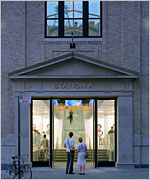A Technique for Architectural Photography
->  <-
<-
Architectural Digest photographer Peter Aaron spoke at the Apple store in SoHo on Monday night (that being his photo of the Apple store under construction at the left). Since my knowledge base about shooting for magazine publishing is comprised of having read several magazines in the past 24 years, it was illuminating even beyond what I was expecting.
After some background, including an interesting aside about his start doing portraiture in Provence before moving on to architecture, Aaron got down to the details.
Although I assumed there was a fair amount of post-production going on with the magazine’s photos, I didn’t realize how important it was. I’ll reverse the order in which he described his process.
Old (Film) Process
In the question and answer period, Aaron described his old technique. He used to take one long (~10 second) exposure of the room lit for the main shot, followed by a series of short (~1/60 of a second) exposures on the same film. During the short exposures he (or his assistant) held a single strobe in different positions around the room to highlight different furniture, art, and angles.
Because of the different exposure times, the light from the strobe shots would show up while the strobe-carrier would not. The result was photograph impossible to do in a single exposure unless one artfully set a number of strobes in positions around the room that cast the desired light while hiding the light source from view.
New (Digital) Process
Like, I suspect, much of modern photography, the new process is very similar to the old process, only with more Photoshop.
As he demonstrated with wonderful clarity in his talk, Aaron now starts with his main shot, then takes a series of shots with increasingly darker and lighter exposures. After these capture the main thrust of the picture, he moves on to the highlights in much the same way as before, with an assistant holding a strobe for shots that bring out different parts of the room.
After finishing work on location, Aaron returns the various RAW files to another assistant who spends his time putting the different layers together in Photoshop, producing the final picture that appears in Architectural Digest.
I wish I had some of the pictures that Aaron used to illustrate his process, as they pretty quickly show what it would take me too long to write. Regardless, this is definitely one idea to file away for the day I move into any sort of extensive Photoshop work.
(I’m also willing to note that this is probably a technique I’d have learned on the third day of a photography class if I’d ever bothered to take one. So its probably not all that interesting to the trained eye, but I thought it was fairly cool.)
